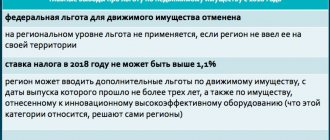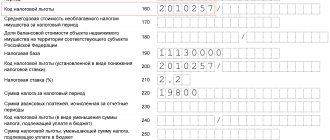Settings for calculating and calculating property tax in 1C 8.3
Step 1. Set rates and benefits
In general, the Tax Code of the Russian Federation establishes the following maximum tax rates:
- For fixed assets, the average annual cost of which is calculated based on the book (residual) value - no more than 2.2% (clause 1 of Article 380 of the Tax Code of the Russian Federation);
- For property with cadastral value - no more than 2% from 2016 onwards (clause 1.1 of Article 380 of the Tax Code of the Russian Federation).
Since the tax rate is set by the law of the constituent entity of the Russian Federation, you need to find out the rate established in your region.
Let's make the appropriate settings in the 1C 8.3 Accounting 3.0 program. Go to the Directories section:
In the Directories we open Property Tax – Rates and benefits:
By default, in 1C 8.3, the date and tax rate are already set in the window that opens. But you can change the data in this line or add a new one.
If an organization applies a maximum rate of 2.2% and does not have tax benefits in the form of an exemption, a reduction in the rate or a reduction in the tax amount, then only the date in the line Installation applies from:
If an organization applies the above tax benefits, then you need to indicate with a checkbox which benefit the organization has the right to apply by filling out the benefit code:
Subjects of the Russian Federation have the right to reduce the tax rate on the tax, which must be entered into the 1C 8.3 program. When reducing the amount of tax in 1C 8.3 Accounting 3.0, the percentage by which the tax is reduced is indicated:
When canceling a tax benefit, you must enter a new entry, indicating the date from which the specified benefit does not apply, unchecking the boxes in the Tax benefits section. In order for the changes made to be accepted in the 1C 8.3 database, you must close all windows using the Write and close function.
Step No. 1 is considered using the example of accounting in 1C 8th edition. 3 property taxes for the entire organization. But there are organizations that have separate fixed assets that have a special taxation procedure. Next, we will consider the procedure for reflecting such property in 1C 8.3.
Step 2. Settings for objects with a special taxation procedure
In the Directories, open the corresponding tab and select Objects with a special taxation procedure:
In 1C 8.3, for each OS with a different taxation procedure (not taxed, registered with another tax authority, assigned a different OKTMO or OKATO, a reduced rate is applied, etc.), a new line (register) with a set date is created:
When creating a new register, review all the tabs that are indicated in the window of this document:
When selecting a fixed asset, the Real Estate Object tab becomes active and the 1C 8.3 program must set the tax base by selecting one of the options: Average annual value (according to accounting data) or Cadastral value.
By default, the 1C 8.3 program selects the Average Annual Cost in the Full Amount and it will be sufficient if you indicate only the date of registration of ownership. If necessary, if ownership is only for a share, then the size of the owned share can be established:
We recommend filling out data for objects with cadastral value in more detail, that is, indicating cadastral numbers, cadastral value as of January 1 and the date of registration of ownership:
Next, let's look at the Tax Authority tab. The data in this bookmark changes only in cases where:
- The OS object has a different OKTMO/OKATO code:
- The OS object belongs territorially to another tax authority, which must be indicated:
Property tax tab: an object with a special taxation procedure is filled in according to the example from step No. 1. By default, in 1C 8.3 the line is marked that Special benefits are not established. If necessary, place a dot at the desired value:
And the last tab in this window, Features, is the affiliation with a particular gas supply facility, a special economic zone, or the territorial location of the facility in another state. If necessary, place a dot at the desired value:
It should be noted that some fixed assets (land plots, water bodies, etc.) are not subject to taxation at all, that is, they are exempt from it. To do this, in 1C 8.3 you need to indicate a tick for such an object Not subject to taxation:
Step 3. Reflection of deadlines for payment of property tax (advance payments)
Note! The procedure and deadlines for paying taxes (advances) are established by the laws of the constituent entities of the Russian Federation:
Having found out the deadlines in your region, you need to set them in the 1C 8.3 Accounting program ed. 3, indicating the tax authority. You need to record the entered data using the Write and close function:
Step 4. Property tax entries
In order for transactions to be generated by cost items in the 1C 8.3 database, it is necessary to make accounting settings in the Methods for reflecting expenses tab:
To determine the cost account, it is necessary to determine for what purposes and departments the asset is used:
- By default, the 1C 8.3 program has accounting account 26 General expenses - the most common among cost accounts. This account for the entire organization can be used by organizations whose activity is the provision of services. It is on this cost account that the amounts of depreciation of fixed assets that are used in the main activity and taxes on these objects are collected.
- Also, account 26 can be used in production and trade organizations to account for the accrual of property taxes and depreciation on objects that are used for management purposes (for example, an administrative building).
- In trading organizations, the main expenses are collected in account 44 Distribution costs in organizations engaged in trading activities.
- Organizations engaged in the production of products can take into account depreciation and tax on fixed assets in accounts 20 Main production, 25 Auxiliary production, 29 Servicing production and facilities.
- Account 91.02 Other expenses takes into account property tax and depreciation on objects that are not used in the main activity (for example, intended for rental).
The above cost accounting accounts are formed in correspondence with account 68.08.
Setting up 1C
Calculation of property tax in 1C must begin with setting the necessary settings. You can configure the program in the menu “Main” - “Accounting Policy” - “Taxes and Reports Settings”.
Fig.1 Setting up 1C
On the left side, move the cursor over the line “Property Tax”.
Fig.2 Property tax
Settings for editing open on the right, which reflect the requirements of current legislation, but the user can adapt some of them, focusing on personal benefits and tax rates in force in the region. So, let’s assume that in the region where business activities are carried out, the current rate from January 1, 2021 is reduced to 1.9%.
If the organization has property that is subject to benefits, the code of the corresponding benefit must also be indicated in the “Benefits” section.
Also in this section it is possible to establish tax rates and establish benefits for individual fixed assets. To do this, click on the line “Objects with a special taxation procedure.”
Fig. 3 Objects with a special taxation procedure
In the window that opens, you can select a fixed asset object, set the date for applying the benefit, and also check a box confirming that this fixed asset object is not subject to taxation. In the “Registration” line (Fig. 4), there are three options to choose from:
- At the location of the organization;
- With a different OKTMO code (allows you to generate payment orders for tax payment using other details);
- In another tax authority.
Fig.4 Registration
In this tab, the accounting type code is also set. When you click on the active button, a window for selecting property groups opens by line.
Fig.5 Window for selecting property groups
In the “Tax benefit” line, you can choose to apply a reduced rate for the object, not apply benefits, or be exempt from taxation.
Fig.6 Tax benefit
As an example, we will reflect the application of a reduced tax rate for the “Shop building” object in the amount of 1% (Fig. 7). The initial cost of the object is 12.0 million rubles (incl. VAT 18% - 2,160.0 thousand rubles).
Fig. 7 As an example, we will show the application of a reduced tax rate for the object “Shop building” in the amount of 1%
Let's return to the "Taxes and Reports Settings" menu. When you click the line “Procedure for paying taxes locally” (Fig. 8), a menu opens that allows you to set settings for choosing a tax authority, the date of tax payment (by default - March 30) and making advance payments.
Fig.8 Procedure for paying taxes locally
In the line “Methods of reflecting expenses”, the default method for reflecting expenses is set to account 26 “General business expenses”; you can change it if desired.
Fig. 9 Methods of reflecting expenses
Calculation of property tax in 1C 8.3
In 1C 8.3, the formation of transactions (Dt Kt) and the calculation of the amount of property tax is carried out through the Month Closing function:
Please note: to activate the function of calculating advance tax payments in 1C 8.3, in the Period window you must select the last month of the quarter: March, June, September, December. When closing other months, this function is not available:
By clicking the Perform month closure button, the line Calculation of property tax will be indicated in green and you can begin viewing the generated accounting records (entries) and the calculation certificate by clicking on this line with the cursor:
You can view the generated transactions (Dt Kt) by clicking Show transactions:
or view how the 1C 8.3 program calculated the tax by clicking on the Property Tax Calculation tab:
View the tax calculation (taxable base, depreciation amount, tax amount, etc.) by moving the cursor at the bottom of the window left and right:
A property tax calculation certificate, which can be submitted upon request of the tax authority, looks like this:
Memo:
- Until 01/01/2013 all fixed assets were subject to taxation.
- From 01/01/2013 It has become necessary to divide objects into movable and immovable, since movable property registered from the specified period is not taxed (clause 1 of Article 374 of the Tax Code of the Russian Federation, No. 202-FZ of November 29, 2012)
- From 01/01/2015 Fixed assets belonging to depreciation groups 1 and 2 (useful life no more than 3 years) are also not taxed (clause 8, clause 4, article 374 of the Tax Code of the Russian Federation).
That is, property can be divided into groups:
- Movable property before 01/01/2013;
- Movable property from 01/01/2013;
- Real estate;
- OS objects of 1-2 groups from 01/01/2015.
The 1C Accounting 8.3 program has the function of determining the taxable base by analyzing the date of registration.
Accounting and tax accounting
Property tax transactions are reflected by the following entries:
Figure 1. Wiring. Author24 - online exchange of student work
These entries are considered standard if the tax is reflected as an expense for ordinary activities. In some cases, the tax amount is classified as other expenses and reflected in the debit of account 91 “Other income and expenses” with the credit of account 68.
Note 1
Due to the fact that the source of funds for paying the tax is not established by law, the procedure for recording it in accounting is also not defined.
Penalties and fines accrued for property tax are reflected by the posting: Dt 99 “Profits and losses” – Kt 68 “Calculations for taxes and fees”.
Organizational property tax is taken into account on the date of accrual. That is, accounting is carried out on the last day of the tax period. Despite this, the date of transfer of funds to the budget does not matter.
Too lazy to read?
Ask a question to the experts and get an answer within 15 minutes!
Ask a Question
How to fill out a property tax return in 1C 8.3
All reports in 1C 8.3 are generated in the Reports – Regulated reports section:
You need to create the required report, then specify the period for which this report needs to be generated:
To automatically fill out a declaration in 1C 8.3, you must click the Fill button. Let's move straight to section 2, where the basic tax data is generated:
In the 1C 8.3 program there is a very good Decrypt function, by clicking on which you can get a detailed report on the data that is included in a particular line of the report.
As you can see, in our example there are fixed assets that are included in the tax base, but have a benefit. This implies a tax exemption for movable property since 2013. In our case, this is vehicle 2, which was registered on 01/01/2013:
Page 2 of Section 2 reflects the average annual value of property, which has neither benefits nor exemption from tax, that is, this property is subject to tax:
Having received the Decoding, you can see that only those fixed assets that are subject to tax remain (the administrative building registered in 2012 and vehicle 1, which was accepted in the same year before the exemption of movable property from tax):
And section 3 of the declaration reflects the fixed assets for which the tax is calculated based on the cadastral value:
For more details on how to fill out a property tax return in 1C 8.3, read our article.
How to check a property tax return in 1C 8.3
To analyze the data in the fixed assets and intangible assets tab, a statement of depreciation of fixed assets is generated, according to which, along with the Calculation Certificate, you can check the correctness of the tax calculation in the declaration:
By default, the Asset Depreciation Sheet looks like this:
In order not to waste time opening the OS card to determine the registration date, using the hint in the Memo above, you need to make internal settings for this register by clicking on the Show settings tab:
Select the Additional fields tab and check the box next to Date accepted for accounting:
It should be noted that there are fixed assets for which the cost and useful life in accounting may differ from tax accounting. In this situation, for clarity, you can:
- On the Indicators tab, check the box next to NU (tax accounting data);
- You also need to check the Depreciation group checkbox in the Grouping tab to select objects by groups:
We will receive a more detailed Statement of Depreciation of Assets, in which, using the Memo , we can analyze which objects should be included in taxable ones:
Having determined the fixed assets that should be included in the tax declaration (in our example: administrative building and vehicle 1), for each line of the declaration you can get a decryption in the form of a Calculation Certificate by pointing the cursor to the desired line and clicking Decrypt:
A calculation certificate is generated:
Finally, in 1C 8.3 you can check the control relationships of data by lines in the declaration:
Study the features of calculating property tax from the cadastral value and from the average annual value, as well as how to prepare the 1C 8.3 database for drawing up a declaration, including: checking the established property tax rate in 1C, reflecting objects with a special taxation procedure, setting up the procedure for paying tax, determining the algorithm (postings) for automatically calculating tax in accounting and accounting systems - you can study in our distance learning course on working in 1C Accounting 8th ed.
3.0
Checking data for correct calculation of advance payments for property tax
Step 1. Checking that the information about the organization is filled out correctly
You can check whether the Organization information in 1C 8.2 is filled out correctly through the Enterprise → Organizations.
Step 2. Checking the property tax rate and information about objects with a special taxation procedure
- Menu Enterprise → Property tax rates ;
- On the Property tax rates - Add , an entry about the amount of the property tax rate is added:
- The Objects with a special taxation procedure tab displays information on fixed assets whose taxation procedure differs from that established for the organization as a whole.
Step 3. Checking the completeness of the reflection of operations for putting fixed assets into operation and changing the initial cost of fixed assets
We check that all operating systems are put into operation and for all operating systems in the case of reconstruction, modernization or technical re-equipment, the operation of increasing their cost is reflected in the 1C 8.2 program.
Step 4. Checking the residual value at the beginning and end of the reporting period
The object of taxation for Russian organizations is property recorded on the balance sheet as fixed assets in the manner established for accounting (Article 374 of the Tax Code of the Russian Federation). To check the residual value of an asset, you can generate two reports:
- The fixed assets depreciation sheet (OS - Asset depreciation sheet - Generate report button) for the first quarter shows the residual value at the beginning and end of the period.
- Balance sheets for accounts 01 “Fixed Assets” and 02 “Depreciation of Fixed Assets” for each month, because the residual value of fixed assets in the declaration must be indicated by month (menu Reports – Account balance sheet): Turnovers on account 01 “Fixed assets” by month, Turnovers on account 02 “Depreciation of fixed assets” by months.
Let's look at an example (the example in question is described in more detail in the previous article):
- The residual value of the Objects subject to tax for the first quarter is as follows:
- As of January 01 – From 1st. (01 account) – Depreciation (02 account) = 100,000 – 48,000 = 52,000 rubles;
- As of February 1 = 100,000 – 52,000 = 48,000 rubles;
- As of March 1 = 100,000 – 56,000 = 42,000 rubles;
- As of April 1 = 100,000 – 60,000 = 40,000 rubles;
- The residual value as of April 1 must correspond to the amount indicated in the Fixed Asset Depreciation Sheet for the first quarter.







